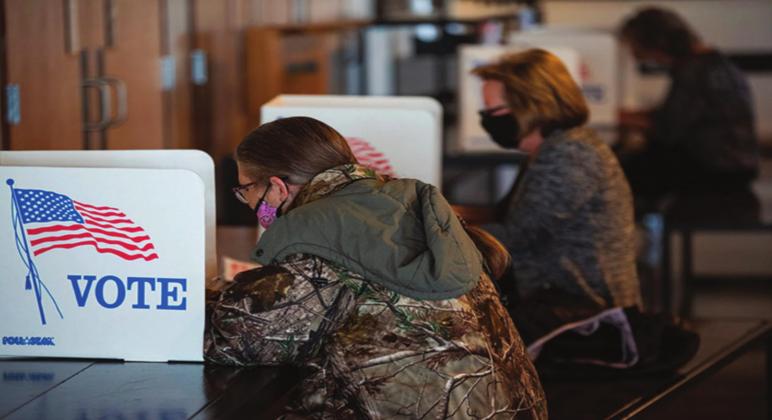More Oklahomans than ever before skipped over selecting individual candidates and instead voted for their party’s entire slate of candidates with a single pen stroke in 2020.
Oklahoma State Election Board data shows that more than 710,200 — or 45.5% of all voters — chose the straightparty voting option during last year’s general election.
That is the most number of straight-party ballots, as well as the highest share of voters choosing this option, in at least the last three presidential elections. In 2016, 36.3% voted using the straight-ticket option and 37.5% voted this way in 2012.
Of those who selected the straight-ticket option last year, 71% were Republicans, 28% Democrats and Libertarians accounted for about 1%. Heading into the election, about 50% of Oklahoma registered voters were Republicans, 33% were Democrats, 16% were independents and less than 1% were libertarians.
The rise in straight-ticket voting comes as a growing number of states have done away with the option.
After a wave of legislative activity across the nation during the past couple decades, Oklahoma is now one of just six states — along with Alabama, Indiana, Michigan, Kentucky and South Carolina — that still allows straight-party voting for partisan offices.
And some state lawmakers are hoping that Oklahoma will leave that group.
Sen. J.J. Dossett, D-Tulsa, introduced legislation ahead of this year’s upcoming legislative session to ban end straight-ticket voting in the state.
He told the Southwest Ledger after filing the bill last month that the voting method is outdated and disincentivizes voters from researching and evaluating individual candidates.
“When Oklahoma was founded more than a century ago, many voters were illiterate and perhaps didn’t have access to information about the candidates,” he told the paper. “(Voters were) more isolated in 1907 and might not have known who the candidates were. So they based their selections on political parties and cast their votes on an emblem or a character: a rooster or donkey for the Democratic Party, an eagle or an elephant for the Republican Party.”
Rep. Trish Ranson, D-Stillwater, is sponsoring a similar bill in the House.
Supporters of straightticket voting say the option is a time-saving convenience that helps speed the voting process.
As in Oklahoma, many of the legislative efforts to end straight-ticket voting have been led by Democrats. But support doesn’t always follow party lines.
In Texas, for instance, Republican lawmakers recently were successful in passing a law banning straight-ticket voting.
That move then was opposed bythe Texas Democratic Party, which sued while arguing that eliminating straight-ticket voting is unconstitutional and intentionally discriminatory because it could trigger longer lines and waiting times at polling places that serve Hispanic and black voters, according to the Texas Tribune. That lawsuit, however, was unsuccessful.
Since 2017, there have been three previous attempts from Oklahoma lawmakers — two from Democrats and one from a Republican — to end straightparty voting.
All three bills died without a committee hearing.
Trevor Brown has been an Oklahoma Watch reporter since 2016. He covers politics, elections, health policies and government accountability issues. Call or text him at (630) 301-0589. Email him at tbrown@oklahomawatch.org . Follow him on Twitter at @ tbrownokc

